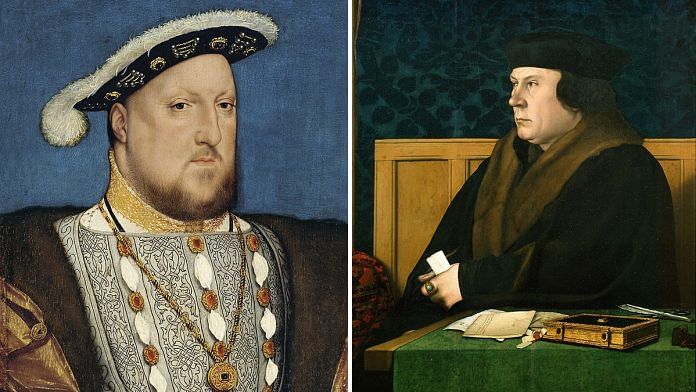New Delhi: Thomas Cromwell, a prime minister of King Henry VIII, may have helped set the course for England to turn Protestant, but appears to have continued to follow traditional Catholic practices at home.
Cromwell, who was part of English political life in the early 16th century, also confiscated land for his personal use — to enlarge the garden of his grand mansion where he one day hoped to entertain the king.
These are some of the many insights that researchers have now revealed using information from a trove of old documents of Cromwell, who was instrumental in separating the Church of England from the authority of the Pope in Rome, a move that is known as The English Reformation, which became a key turn in English and European political history.
Using letters and historical leases, researchers have recreated the private mansion of Cromwell, no doubt the centre of many a palace intrigue as he was one of the most powerful men of the king’s inner circle.
Nick Holder, a historian and research fellow at University of Exeter, UK, scrutinised letters, leases, surveys and inventories to present the most thorough insight to date on “one of the most spectacular private houses” in 1530s London. His findings published in the Journal of the British Archaeological Association Wednesday include floor plans for the mansion, which had 58 rooms besides servants’ garrets and a large garden.
Also read: If India can’t contribute to Taliban’s defeat, it must prevent their victory
What Thomas Cromwell’s house reveals about Thomas Cromwell
The London mansion cost Cromwell at least £1,600 to build, including around £550 for the land. According to Holder, it is likely that the architecture contained Italian Renaissance features that were new and fashionable for that time.
The construction for the mansion — that had bedding made of gold, damask and velvet — began in July 1535. It acted as a family home, an administrative base and a venue for entertainment. Its design suggests that Cromwell may have anticipated visits from the king.
Cromwell also seems to have undertaken a “land grab”, confiscating a 22-foot strip of land to enlarge his garden, which may have had a bowling alley and tennis court.
According to Holder’s study, prestigious visitors would have been guided up the large stair tower to one of the first-floor halls and the ladies parlour. The heated halls were decorated with tapestry hangings.
The mansion also stored Cromwell’s personal armour, which would have been enough for a small army. The collection included several hundred sets of German plate armour for infantry, nearly 100 head-pieces and helmets, and weaponry, including 759 bows, complete with hundreds of sheaves of arrows.
Before moving to the mansion, Cromwell lived in a 14-room townhouse. Documents provide a room-by-room description of this home and its contents. They also give a glimpse into his religious outlook.
“No one else has looked at these two houses in quite as much detail comparing all the available evidence. This is about as close as you are going to get to walking down these 16th-century corridors,” Holder said in a statement.
“We think of Cromwell as Henry VIII’s henchman, carrying out his policy, including closing down the monasteries, and we know that by about 1530 Cromwell became one of the new Evangelical Protestants,” Holder further said.
“But when you look at the inventory of his house in the 1520s, he doesn’t seem like such a religious radical, he seems more of a traditional English Catholic,” he said in the statement.
“He’s got various religious paintings on the wall, he’s got his own holy relic, which is very much associated with traditional Catholics, not with the new Evangelicals, and he’s even got a home altar. In the 1520s he seems like much more of a conventional early Tudor Catholic gentleman,” he added.
The analysis was made possible by looking at documents held in the archives of the Drapers’ Company, the trade group that bought Cromwell’s mansion after his death. The findings have also helped illustrator Peter Urmston recreate what the mansion would have looked like for the first time, which since his beheading had fallen into neglect.
Also read: Imran Khan, Emmanuel Macron, Cyril Ramaphosa among 14 world leaders on Pegasus ‘hacking’ list
Cromwell’s rise and the English Reformation
Henry VIII was dissatisfied with his relationship with the then Queen of England, Catherine of Aragon. He was known to have many mistresses in court. However, when he became smitten with Anne Boleyn, a maid of honour to his first wife, Boleyn refused to be his mistress.
Cromwell is thought to have played a key role in engineering the annulment of the king’s marriage with Catherine, an act that freed the king to marry Boleyn, which eventually led the Church of England to break away from the authority of the Pope and the Roman Catholic Church. It also made the king of England the head of the Church allowing him to annul his own marriages.
Despite being one of Henry’s favourites, Cromwell fell out of favour and was eventually executed in 1540 — but, till date, he continues to capture the public imagination and has inspired novels, including Hilary Mantel’s award-winning Wolf Hall series, plays and TV series.
(Edited by Paramita Ghosh)
Also read: Talha Talib had a near-miss at Tokyo. But Pakistanis’ worry is small Olympics contingent






